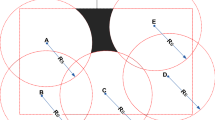Abstract
The coverage framework and the installation policies are straightforwardly linked to the feasible distribution of the restricted resources for the wireless sensor network like node energy, transmission bandwidth and energy for estimation along with the quality enhancement which is immensely resolved for the wireless sensor networks. A three-dimensional coverage model and installation scheme are designed which initially performs an assessment of the usual polyhedron frameworks in the three-dimensional prospects, a coverage model based on cuboids is proposed. The association among the coverage and sensor nodes is assumed along with the minimal number of sensor nodes to preserve the network regions comprehensive coverage is estimated. Lastly, the sensor nodes are installed based on the coverage model after the observation region which is subclassified into restricted three-dimensional grids. The results of analysis reveal that the evaluation against the conventional arbitrary schemes, the sensor number of sensor nodes are minimized efficiently based on the precise ratio of coverage employing the coverage framework and deterministic installation methods.







Similar content being viewed by others
References
Onur, O. E., Ersoy, C., Delic, H., & Akarun, L. (2007). Surveillance wireless sensor networks: deployment quality analysis. IEEE Network,21(6), 48–53.
Kumar, S., & Lobiyal, D. K. (2013). Sensing coverage prediction for wireless sensor networks in the shadowed and multipath environment. The Scientific World Journal, Vol. 2013, Article ID 565419.
Heidemann, J., Ye, W., Wills, J., Syed, A., & Li, Y. (2006). Research challenges and applications for underwater sensor networking. In Proceedings of the IEEE wireless communications and networking conference (WCNC’06) (pp. 228–235). Las Vegas, Nev, USA.
Dhillon, S. S., & Chakrabarty, K. (2002). Sensor placement for grid coverage under imprecise detections. In Proceeding of the international conference on information fusion (pp. 1581–1587). Annapolis, MD, USA.
Dhillon, S. S., & Chakrabarty, K. (2003). Sensor placement for effective coverage and surveillance in distributed sensor networks. In Proceedings of the IEEE wireless communications and networking conference (pp. 1609–1614). New Orleans, LA, USA.
Bai, X. L., Yun, Z. Q., Xuan, D., Lai, T. H., & Jia, W. (2008). Deploying four-connectivity and full-coverage wireless sensor networks. In Proceedings of the 27th IEEE communications society conference on computer communications (INFOCOM’08) (pp. 296–300). Phoenix, Ariz, USA.
Ammari, H. M., & Das, S. K. (2009). Critical density for coverage and connectivity in three-dimensional wireless sensor networks using continuum percolation. IEEE Transactions on Parallel and Distributed Systems,20(6), 872–885.
Pompili, D., Melodia, T., & Akyildiz, I. F. (2009). Three-dimensional and two-dimensional deployment analysis for underwater acoustic sensor networks. Ad Hoc Networks,7(4), 778–790.
Akkaya, K., & Newell, A. (2009). Self-deployment of sensors for maximized coverage in underwater acoustic sensor networks. Computer Communications,32(7), 1233–1244.
Ammari, H. M., & Das, S. K. (2010). A study of k-coverage and measures of connectivity in 3D wireless sensor networks. IEEE Transactions on Computers,59(2), 243–257.
Alam, S. N., Haas, Z. J. (2006). Coverage and connectivity in three-dimensional networks. In Proceedings of the ACM MobiCom (pp. 346–357). Los Angeles, Calif, USA.
Watfa, M. K., & Commuri, S. (2006). The 3-dimensional wireless sensor network coverage problem. In Proceedings of the IEEE international conference on networking, sensing and control (ICNSC ‘06) (pp. 856–861). Gainesville, FL, USA.
Amac Guvensan, M., & Gokhan Yavuz, A. (2011). On coverage issues in directional sensor networks: A survey. Ad Hoc Networks,9(7), 1238–1255.
Liu, L., & Ma, H. (2012). On coverage of wireless sensor networks for rolling terrains. IEEE Transactions on Parallel and Distributed Systems,23(1), 118–125.
Topcuoglu, H. R., Ermis, M., & Sifyan, M. (2011). Positioning and utilizing sensors on a 3-D terrain part I-theory and modeling. IEEE Transactions on Systems, Man and Cybernetics C: Applications and Reviews,41(3), 376–382.
Topcuoglu, H. R., Ermis, M., & Sifyan, M. (2011). Positioning and utilizing sensors on a 3-D terrain part II-Solving with a hybrid evolutionary algorithm. IEEE Transactions on Systems, Man and Cybernetics C: Applications and Reviews,41(4), 470–480.
Kong, L., Zhao, M., Liu, X., Liu, Y., Wu, M., & Shu, W. (2014). Surface coverage in sensor networks. IEEE Transaction on Parallel and Distributed Systems,25(1), 234–243.
Author information
Authors and Affiliations
Corresponding author
Additional information
Publisher's Note
Springer Nature remains neutral with regard to jurisdictional claims in published maps and institutional affiliations.
Rights and permissions
About this article
Cite this article
Karthikeyan, A., Arunachalam, V.P. & Karthik, S. Attempting to Model a Fresh Three Dimensional Coverage Scheme for Wireless Sensor Networks. Wireless Pers Commun 110, 847–859 (2020). https://doi.org/10.1007/s11277-019-06759-3
Published:
Issue Date:
DOI: https://doi.org/10.1007/s11277-019-06759-3




